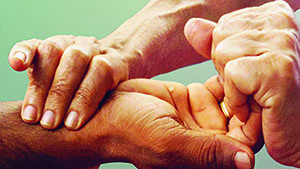 According to Ayurveda, the presence of disease in our system indicates an imbalance in our ‘doshas’. The cure includes bringing our system back to balance. Ayurveda has an effective tool for the diagnosis of disease called ‘nadi pariksha’ or pulse diagnosis. This is done by an Ayurvedic doctor who checks the individual’s pulse to detect imbalances in the body.
According to Ayurveda, the presence of disease in our system indicates an imbalance in our ‘doshas’. The cure includes bringing our system back to balance. Ayurveda has an effective tool for the diagnosis of disease called ‘nadi pariksha’ or pulse diagnosis. This is done by an Ayurvedic doctor who checks the individual’s pulse to detect imbalances in the body.
It is important to understand the full implication of nadi pariksha. It is not just a technique to study the venous pulsation in the wrist. Nadi science is the science of nerves, which includes the study of life processes. Nadi is said to be jiva sakshii, the evidence of life.
Nadi gets influenced by various effects that influence the physiology of the body, especially the three doshas. i.e. Vata, Pitta and Kapha. The dhamani or the nadi mentioned here refers to radial artery. Its motion does not merely indicate the rate or the rhythm of the pulse, the size and condition of the arterial wall or the volume of blood that flows or the force with which it flows. The motion of this nadi is also indicative of the imbalance of the three doshas.
In ayurvedic texts there are certain criteria that help in judging the death of a patient in the near future. It is often said that nadi doctors can predict the gender of the baby in a pregnant woman’s womb. A friend of mine once referred to a nadi doctor who deciphered the state of her relationship from her nadi. Apart from these hormonal imbalances, digestion issues, kidney and liver related problems, blood pressure, diabetes and many other physical and mental ailments can be detected through this diagnosis process.
The Art of Living Foundation is bringing back the age old technique of nadi pariksha which is an integral part of the ancient science of Ayurveda. Ayurveda diagnoses and cures diseases which are on the verge of developing and has no side effects is preventive in nature.
Add new comment